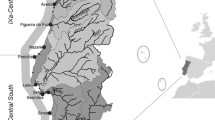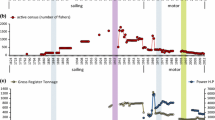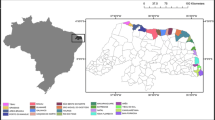Abstract
The purpose of this paper is to investigate the environmental nature of the French Guiana shrimp fishery dynamics through an empirical analysis. To do so, we specify a global harvest production function, in which the output depends on the number of days at sea and the stock level. In addition, we use some environmental variables representing the ‘El Niño’ and ‘la Niña’ phenomena, the sea surface temperature, and the flow of some Amazonian rivers as instruments. This method enables us to correct the well-known simultaneous bias between the harvest and the stock levels and to show that harvest is significantly dependent on the environmental factors analyzed, which may compromise the future of the French Guiana shrimp fishery in the context of climate change.



Similar content being viewed by others
Notes
The French Guiana constitutes one of the richest areas in terms of biodiversity in the world, the fourth as marine fish is concerned.
The term “El Niño” (meaning the “Christ Child” in Spanish) is used by fishermen in Ecuador and Peru to refer to a warmer than normal ocean current observed immediately after Christmas every few years.
References
Arnason R (2003) Global warming and North Atlantic fisheries: attempting to assess the economic impact. Working paper presented at the FAME workshop, Copenhagen. IGES Oceanography Committee ICES CM 2006/OCC: 12 REF. ACFM, ACE, RMG
Barbier EB (1998) Valuing mangrove–fishery linkages—a case study of Campeche, Mexico. Environ Resour Econ 12(2):151–166
Barbier EB (2000) Valuing the environment as input: review of applications to mangrove–fishery linkages. Ecol Econ 35(1):47–61
Barbier EB (2003) Habitat–fishery linkages and mangrove loss in Thailand. Contemp Econ Policy 21(1):59–77
Beaumont LJ, Hughes L (2002) Potential changes in the distributions of latitudinally restricted Australian butterfly species in response to climate change. Glob Change Biol 8:954–971
Bjørndal T (1987) Production economics and optimal stock size in a North Atlantic Fishery. Scand J Econ 89:145–164
Bjørndal T (1989) Production in a schooling fishery: the case of the North Sea herring fishery. Land Econ 65(1):49–56
Bjørndal T, Gordon DV (1993) The opportunity cost of capital and optimal vessel size in the Norwegian fishing fleet. Land Econ 69(1):98–107
Bjørndal T, Gonrad DV, Salvanes KG (1993) Stock size, harvesting costs, and the potential for extinction: the case of sealing. Land Econ 69(2):156–167
Brown JH, Stevens GC, Kaufman DM (1996) The geographic range: size, shape, boundaries, and internal structure. Ann Rev Ecol Syst 27:597–623
Chaboud C, Thébaud O (2009) 18th World IMACS/MODSIM Congress, Cairns, Australia 13–17 July 2009. http://archimer.ifremer.fr/doc/00243/35473/
Clark GW (1976) Mathematical bioeconomics: the optimal management of renewable resources. Wiley, New York
Daskalov G (1999) Relating fish recruitment to stock biomass and physical environment in the Black Sea using generalized additive models. Fish Res 41:1–23
Dunlap RE (1991) Trends in public opinion toward environmental issues: 1965 à 1990. Soc Natural Resour 4(3):285–312
Eide A, Heen K (2002) Economic impacts of global warming: a study of the fishing industry in North Norway. Fish Res 56(3):261–274
Gallède J, Guyot JL, Ronchail J, L‘Hote Y, Niel H, De Olivera E (2004) Evolution of the River Amazon’s discharge at Óbidos from 1903 to 1999. Hydrol Sci J 49(1):85–97
Garza-Gil MD, Torralba-Gano J, Varela-Lafuente MM (2011) Evaluating the economic effects of climate change on the European sardine fishery. Reg Environ Change 11:87–95
Gaston K (1990) Patterns in the geographical ranges of species. Biol Rev 66:106–129
Gratiot N, Anthony EJ, Gardel A, Gaucherel C, Proisy C, Wells JT (2008) Significant contribution of the 18.6 year tidal cycle to regional coastal changes. Nat Geosci 1:169–172
Gulland JA (1965) Estimation of mortality rates. Appendix to Arctic Fisheries Working Group Report, IGES G.M. Doc No3
Hart PJB, Reynolds JD (2002) Banishing ignorance: underpinning fisheries with basic biology. In: Hart PJB, Reynolds D (eds) Handbook of fish biology and fisheries. Blackwell Science Ltd, Oxford, pp 1–12
Hausman JA (1978) Specification tests in econometrics. Econometrica 46(6):1261–1271
Healey MC, Hennessey T (1998) The paradox of fairness: the impact of escalating complexity on fishery management. Mar Policy 22(2):109–118
Hengeveld R, Haeck J (1982) The distribution of abundance. I measurements. J Biogeogr 9:303–316
Huntley B (1994) Plant species’ response to climate change: implications for the conservation of European birds. Ibis 137:127–138
Ishimura G, Herrick S, Sumaila UR (2013) Fishing games under climate variability: transboundary management of Pacific sardine in the California current system. Environ Econ Policy Studies 16(2):189–209
Kutkuhn JB (1966) Dynamics of a Penaeid shrimp population and management implications. Fish Bull 65:313–338
Lampert L (2011a) Etude de la crise de la pêche de la crevette en Guyane. Volume 1: effets de la pêcherie-hypothèses des causes. Rapport RST IFREMER/BIODIVHAL 2011–2016, Cayenne, 62 p. + annexe. http://archimer.ifremer.fr/doc/000t6/18584/16138.pdf. Accessed 20 Aug 2013
Lampert L (2011b) Mode d‘emploi du script R pour le calcul par VPA du nombre de recrus de crevettes et de leur biomasse. Rapport RST IFREMER/BIODIVHAL 2011–1, Gayenne, 40 p. + annexe. http://archimer.ifremer.fr/doc/00075/18615/16168.pdf. Accessed 3 Oct 2013
Lawton JH (2000) Community ecology in a changing world. In: Kinne O (ed) Excellence in ecology, p 227
Mack RN (1996) Predicting the identity and fate of plant invaders: emergent and emerging approaches. Biol Cons 78:107–121
Martinez JM, Guyot JL, Filizola N, Sondag F (2009) Increase in suspended sediment discharge of the Amazon River assessed by monitoring network and satellite data. Catena 79:257–264
Maurer BA (1999) Untangling ecological complexity. University of Chicago Press, Chicago
Mooney HA (1991) Biological response to climate change: an agenda for research. Ecol Appl 1:112–117
Peña-Torres J, Agostini C, Vergara S (2007) Fish stock endogeneity in a harvest function: ‘El Niño’ Effects on the Chilean Jack Mackerel Fishery. Revista de Anàlisis Económico 22(2):75–99
Reynolds RW, Rayner NA, Smith TM, Stokes DC, Wang W (2002) An improved in situ and satellite SST analysis for climate. J Clim 15(13):1609–1625
Rogers DJ, Randolph SE (1993) Distribution of tsetse and ticks in Africa: past, present and future. Parasit Today 9:266–271
Schaefer MB (1957) Some considerations of population dynamics and economics in relation to the management of marine fishes. J Fish Res Board Can 14:669–681
Sparre P, Venema SG (1998) Introduction to tropical fish stock assessment. Part 1 manual, Rev. 2. FAO. Fish. Tech. Pap. 306/1(Rev. 2), Rome, FAO, p 407
Sun GH, Chiang FS, Tsoa E, Chen MH (2006) The effects of El Niño on the mackerel purse-seine fishery harvests in Taiwan: an analysis integrating the barometric readings and sea surface temperature. Ecol Econ 66(2):268–279
Vendeville PH, Rosé J, Viera A, Blanchard F (2008) Durabilité des activités halieutiques et maintien de la biodiversité marine en Guyane. Rapport IFOP-GPER. Ifremer, Gayenne, 316 p. ‡ annexe. http://archimer.ifremer.fr/doc/00085/19595/. Accessed 8 Jan 2014
Yagi M, Managi S (2011) Catch limits, capacity utilization and cost reduction in Japanese fishery management. Agric Econ 42:577–592
Acknowledgments
We would like to thank Bouchra M'Zali, attendees of NRM conference in Bordeaux, Of Gdr Liga conference in French Guiana, and anonymous referees for comments on various versions of this paper. The research has been supported by a grant from European Social Fund (FSE), National Centre for Space Studies (CNES), Overseas ministry (MOM).
Author information
Authors and Affiliations
Corresponding author
About this article
Cite this article
Sanz, N., Diop, B., Blanchard, F. et al. On the influence of environmental factors on harvest: the French Guiana shrimp fishery paradox. Environ Econ Policy Stud 19, 233–247 (2017). https://doi.org/10.1007/s10018-016-0153-6
Received:
Accepted:
Published:
Issue Date:
DOI: https://doi.org/10.1007/s10018-016-0153-6




